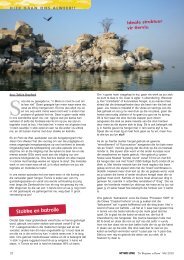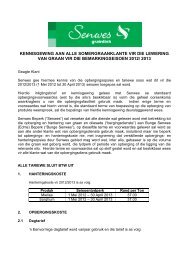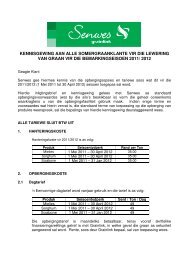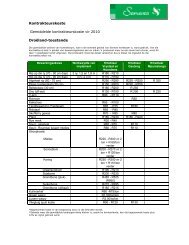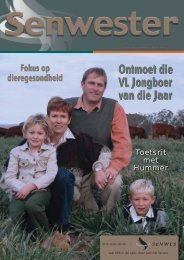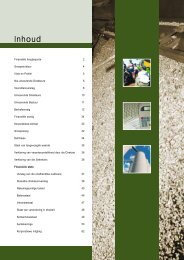Create successful ePaper yourself
Turn your PDF publications into a flip-book with our unique Google optimized e-Paper software.
Maximi<strong>se</strong><br />
Neil du Sautoy<br />
Agricultural Services<br />
your soil potential<br />
Dr Neil du Sautoy, Natural Resources Specialist of Senwes Agricultural Services, discus<strong>se</strong>s<br />
the challenges and opportunities that modern technology and re<strong>se</strong>arch bring<br />
to soil as<strong>se</strong>ssments.<br />
Plant growth is driven by trapping<br />
energy from the sun and using it to<br />
convert carbon dioxide into plant<br />
material through the process of photosynthesis.<br />
A plant acquires carbon<br />
dioxide by opening the stomata in the<br />
leaf (Figure 1). When the stomata are<br />
open, water is lost from the plant in a<br />
process known as transpiration. Loss<br />
of water is the natural tax that a plant<br />
must pay to get its basic requirements!<br />
Ba<strong>se</strong>d on this principle, Tanner<br />
and Sinclair showed in 1983 that daily<br />
plant growth is directly proportional to<br />
the amount of water a plant transpires<br />
38 Senwester, Julie 2005<br />
per day and inver<strong>se</strong>ly proportional to<br />
the dryness of the atmosphere (i.e.<br />
vapour pressure deficit), thus:<br />
Daily plant growth = k*(T/V)<br />
Where k is a plant constant known<br />
as the dry matter water ratio, T is transpiration<br />
in mm and V is the vapour<br />
pressure deficit.<br />
Put numbers to<br />
intuitive ob<strong>se</strong>rvations<br />
This principle, coupled with a<br />
<strong>se</strong>ries of other algorithms describing<br />
Figure 1: Diagrammatic repre<strong>se</strong>ntation of transpiration – open stomata in a leaf<br />
allow carbon dioxide intake, whilst losing water.<br />
crop growth proces<strong>se</strong>s is the basis of<br />
re<strong>se</strong>arch done by the University of<br />
Pretoria (funded by the Water<br />
Re<strong>se</strong>arch Commission) to establish<br />
the Soil Water Balance Model. This<br />
re<strong>se</strong>arch has shown that by following<br />
the water balance in the soil-plantatmosphere-continuum,<br />
a very good<br />
indication of the production potential<br />
of a soil-climate unit can be derived.<br />
Re<strong>se</strong>arch done by the University of<br />
the Free State has also shown the<br />
value of including climate in as<strong>se</strong>ssments,<br />
i.e. the SWAMP model.<br />
The value of the<strong>se</strong> models are<br />
that, with the u<strong>se</strong> of modern technology<br />
such as desktop computers and<br />
automated climate monitoring systems,<br />
it is possible to put numbers to<br />
intuitive ob<strong>se</strong>rvations. For example<br />
we know maize yields in the<br />
Bethlehem district are lower than<br />
other regions due to lower heat units<br />
while the Schweizer-Reneke district<br />
has ample heat units, but rainfall is a<br />
limitation.<br />
New opportunities and<br />
challenges for soil<br />
cartographers<br />
The<strong>se</strong> models have opened new<br />
opportunities, as well as challenges,<br />
to soil cartographers when as<strong>se</strong>ssing<br />
lands. The opportunity is that by<br />
adopting the<strong>se</strong> techniques soil cartographers<br />
can derive more accurate<br />
and scientifically ba<strong>se</strong>d estimates on<br />
yield potential of soils. This is es<strong>se</strong>ntial<br />
for effective precision farming and<br />
sound management of the natural<br />
resources.<br />
The challenge is to numerically






